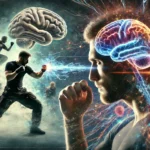Aggression has always been a cornerstone of Krav Maga. However, fully embracing this mindset often gets overlooked, especially when training focuses solely on mechanical movements. Students often get caught up in memorizing steps without understanding the underlying motivation. Whether you are an instructor or a student, it is crucial to constantly align your mental state with the actions you are training for. Remember, the ultimate goal is survival, and that starts with an emotional response that triggers our aggressive nature, not just the technique itself.
Stories of overwhelming aggression saving lives are not hard to find. Whether it’s a random individual, a law enforcement officer, or a soldier, people facing overwhelming odds often manage to overcome them through sheer aggressive determination. Often, their drive stems from a deep emotional response—thinking of loved ones or the fear of loss—that allows them to tap into their inner strength and prevail.
A Student’s Story
One of my students, a 16-year-old named Sam, shared an experience that underscores the importance of mental preparedness. She was attacked in a mall parking lot. As someone grabbed her from behind, her initial reaction was fear. But instead of freezing, she thought only of getting back to her mother. This emotional trigger unleashed her aggression, and she instinctively elbowed the attacker in the face, allowing her to escape. This story reinforces the critical role of mental and emotional training in real-life scenarios.
Overcoming the Body’s Natural Stress Responses
During a violent encounter, our bodies undergo rapid changes. According to Robert B. Kauffman in “Psychology of Survival – Who Survives,” the body’s reaction to fear is deeply rooted in evolution. It prepares for fight or flight by altering blood chemistry, increasing blood pressure and heart rate, reducing peripheral vision, impairing auditory function, flooding the brain with hormones, reducing fine motor skills, and boosting adrenaline for energy and pain suppression. To handle an attack effectively, we must also manage these physiological responses.
The Importance of Aggression Training for New Students
Aggression training is particularly vital for new students who have yet to master all self-defense techniques. Teaching them to use their emotional responses to trigger anger and aggression makes any action more effective and enhances their survival chances. According to research by Matsumoto, Hwang, and Frank, expressions of fear versus anger significantly impact one’s well-being; those who express anger are less likely to be assaulted. Therefore, we must teach our students to harness their emotional responses to fuel their aggression and physical responses.
Training Exercises to Unleash the Inner Monster
One effective exercise involves using a tombstone or curved shield. Initially, students strike the pad with 10% effort for 10-15 seconds. Then, they think of something happy and repeat the drill, followed by striking while breathing through the nose, then the mouth. This highlights how breathing affects performance, with mouth breathing providing more oxygen for better muscle function. After striking all out for 30 seconds, they calm down by breathing in through the nose and out through the mouth.
Next, students recall something that makes them angry and strike the pad again. This time, they strike with increased intensity due to the emotional trigger. Repeating the drill while visualizing a loved one in danger pushes them to even higher levels of aggression and intensity. Verbalizing their anger with growls or yells further enhances their performance.
Finally, encouraging students to strike while you shout motivational commands like “hit them” and “don’t quit” integrates the emotional and physical aspects of the exercise. This drill, taking only 15 minutes, teaches students to control their inner monster. They practice mental imagery, breathing, and verbal aggression in slow motion, learning to manage their intensity and control.
Enhancing Learning, Retention, and Recall of Techniques
Our memories are strongly linked to emotions. Emotional events activate the amygdala and hippocampus simultaneously, making memories more vivid and easier to recall. By attaching strong emotions to their training, students can learn techniques faster, store them more accurately, and recall them under stress.
In conclusion, integrating strong emotions into your training enhances learning, retention, and recall. Visualize someone hurting your loved one while practicing strikes, chokes, or weapon defenses to unleash your inner monster, learn faster, and perform effectively under stress.
I look forward to seeing you all on the mats. Kida.
Michael Berean, Krav Maga 3rd Degree Black Belt



